Bilbo Baggins
Bilbo Baggins is the title character and protagonist of J. R. R. Tolkien's 1937 novel The Hobbit, a supporting character in The Lord of the Rings, and the fictional narrator of all Tolkien's Middle-earth writings. The Hobbit is selected by the wizard Gandalf to help Thorin and his party of Dwarves to reclaim their ancestral home and treasure, which has been taken over by the dragon Smaug. Bilbo sets out in The Hobbit timid and comfort-loving, and through his adventures grows to become a useful and resourceful member of the quest.
| Bilbo Baggins | |
|---|---|
| The Hobbit, The Lord of the Rings, Bilbo's Last Song character | |
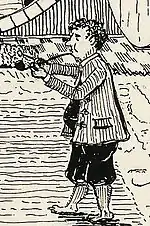 J. R. R. Tolkien's illustration of Bilbo in his comfortable hobbit-hole, Bag End | |
| In-universe information | |
| Race | Hobbit |
| Family | Belladonna Took (mother) Bungo Baggins (father) Gerontius "The Old" Took (grandfather) Frodo Baggins (cousin) |
| Home | The Shire |
"Baggins" is from a Yorkshire dialect word for tea as a meal. Bilbo's way of life in the Shire, defined by features like the availability of tobacco and a postal service, would be English and middle class, and its period would be in the Victorian to Edwardian eras. This is not compatible with the much older world of Dwarves and Elves. Tolkien appears to have based Bilbo on the designer William Morris's travels in Iceland; Morris liked his home comforts but grew through his adventurous journeying. Bilbo's quest has been interpreted as a pilgrimage of grace, in which he grows in wisdom and virtue, and as a psychological journey towards wholeness.
Bilbo has appeared in numerous radio and film adaptations of The Hobbit and The Lord of the Rings, and in video games based on them. Several astronomical features and both living and fossil species have been named for him.
Appearances
The Hobbit
In The Hobbit, the protagonist Bilbo Baggins, a hobbit in comfortable middle age, is hired as a "burglar", despite his initial objections, by the wizard Gandalf and 13 Dwarves led by their king in exile, Thorin Oakenshield. The Dwarves are on a quest to reclaim the Lonely Mountain and its treasures from the dragon Smaug.[T 1] The adventure takes Bilbo and his companions through the wilderness,[T 2] to the elf haven of Rivendell,[T 3] across the Misty Mountains where, escaping from goblins,[T 4] he meets Gollum and acquires a magic ring.[T 5] His journey continues via a lucky escape from wargs, goblins, and fire,[T 6] to the house of Beorn the shapeshifter,[T 7] through the black forest of Mirkwood,[T 8] to Lake-town in the middle of Long Lake,[T 9] and eventually to the Mountain itself.[T 10]
As burglar, Bilbo is sent down the secret passage to the dragon's lair. He steals a golden cup and takes it back to the Dwarves. Smaug awakes and instantly notices the theft and a draught of cold air from the opened passage. He flies out, nearly catches the Dwarves outside the door, and eats their ponies. Bilbo and the Dwarves hide inside the passage. Bilbo goes down to Smaug's lair again to steal some more, but the dragon is now only half-asleep. Bilbo, wearing his magic ring, is invisible, but Smaug at once smells him. Bilbo has a riddling conversation with Smaug, and notices that the dragon's armour has a gap. He escapes the dragon's flames as he runs up the passage, and tells the Dwarves about the gap in Smaug's armour. An old thrush hears what he says, and flies off to tell Bard in Lake-town.[T 11]
Smaug realizes that Lake-town must have helped Bilbo, and flies off in a rage to destroy the town. The Dwarves and Bilbo hear that Smaug has been killed in the attack. The Dwarves reclaim the Lonely Mountain, and horrify Bilbo by refusing to share the dragon's treasure with the Lake-men or the Wood-elves. Bilbo finds the Arkenstone of Thrain, the most precious heirloom of Thorin's family, and hides it. Thorin calls his relative Dáin to bring an army of Dwarves.[T 12] Thorin and his Dwarves fortify the entrance to the mountain hall, and are besieged by the Wood-elves and Lake-men. Bilbo tries to ransom the Arkenstone to prevent fighting, but Thorin sees his action as betrayal, and banishes Bilbo. Dain arrives, and the army of Dwarves faces off against the armies of Elves and Men. As battle is joined, a host of goblins and wargs arrive to take over the mountain, now that Smaug is dead. The armies of Elves, Men, and Dwarves, with the help of Eagles and Beorn, defeat the goblins and wargs.[T 13] Thorin is fatally wounded, but has time to make peace with Bilbo. Bilbo accepts only a little of the treasure which was his share, though it still represents great wealth for a Shire hobbit. Bilbo returns to his home in the Shire to find that several of his relatives, believing him to be dead, are trying to claim his home and possessions.[T 14]
The Lord of the Rings
The Lord of the Rings begins with Bilbo's "eleventy-first" (111th) birthday, 60 years after the beginning of The Hobbit. The main character of the novel is Frodo Baggins, Bilbo's cousin,[lower-alpha 1] who celebrates his 33rd birthday and legally comes of age on the same day. Bilbo has kept the magic ring, with no idea of its significance, all that time; it has prolonged his life, leaving him feeling "thin and stretched". At the party, Bilbo tries to leave with the ring, but Gandalf persuades him to leave it behind for Frodo.[T 15] Bilbo travels to Rivendell and visits the dwarves of the Lonely Mountain before returning to retire at Rivendell and write books.[T 16] Gandalf discovers that Bilbo's magic ring is the One Ring forged by the Dark Lord Sauron, and sets in motion the quest to destroy it.[T 17] Frodo and his friends set off on the quest, finding Bilbo, now obviously aged, in Rivendell.[T 16] When they have destroyed the Ring, they return to the Shire, via Rivendell, where Bilbo looks "very old, but peaceful, and sleepy".[T 18][T 19] Two years later Bilbo accompanies Gandalf, Elrond, Galadriel, and Frodo to the Grey Havens, there to take ship for Tol Eressëa across the sea.[T 20]
Narrator
In Tolkien's narrative conceit, in which all the writings of Middle-earth are translations from the fictitious volume of the Red Book of Westmarch, Bilbo is the author of The Hobbit, translator of various "works from the elvish",[T 21] and the author of the following poems and songs:
- "A Walking Song"[T 22]
- "All that is gold does not glitter", based on Shakespeare's The Merchant of Venice, which uses "glisters" instead of "glitters"[1]
- "The Man in the Moon Stayed Up Too Late",[T 23] adapted from the nursery rhyme "Hey Diddle Diddle", supposedly as its ancestral form[2]
- "The Road Goes Ever On"[T 24]
- "Bilbo's Last Song", describing Bilbo's contemplation of his forthcoming voyage to the Undying Lands.[3]
Interpretations
Name
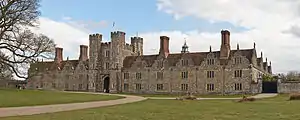
The critic Tom Shippey notes that "Baggins" is close to the spoken words bæggin, bægginz in the dialect of Huddersfield, Yorkshire,[5][6] where it means a substantial meal eaten between main meals, most particularly at teatime in the afternoon; and Mr Baggins is definitely, Shippey writes, "partial to ... his tea".[6] The choice of the surname may be connected to the name of Bilbo's house, Bag End, also the actual name of Tolkien's aunt's farmhouse, which Shippey notes was at the bottom of a lane with no exit. This is called a "cul-de-sac"[lower-alpha 2] in England; Shippey describes this as "a silly phrase", a piece of "French-oriented snobbery", and observes that the socially aspiring Sackville-Bagginses have similarly attempted to "Frenchify" their family name, Sac[k]-ville = "Bag Town", as a mark of their bourgeois status.[7] The journalist Matthew Dennison, writing for St Martin's Press, calls Lobelia Sackville-Baggins "Tolken's unmistakable nod to Vita Sackville-West", an aristocratic novelist and gardening columnist as passionately attached to her family home, Knole House, which she was unable to inherit, as Lobelia was to Bag End.[4] The opposite of a bourgeois is a burglar who breaks into bourgeois houses, and in The Hobbit Bilbo is asked to become a burglar (of Smaug the dragon's lair), Shippey writes, showing that the Bagginses and the Sackville-Bagginses are "connected opposites".[7] However, he also observes that the name Sackville-Baggins, for the snobbish branch of the Baggins family,[6] is "an anomaly in Middle-earth and a failure of tone".[9]
Period
Bilbo's period can be defined, Shippey notes, by the presence of tobacco, brought to Europe in 1559, and a postal service, introduced in England in 1840.[7][lower-alpha 3] Like Tolkien himself, Bilbo was "English, middle class; and roughly Victorian to Edwardian", something that as Shippey observes, does not belong in the much older world of elves, dwarves, and wizards.[7]
Character
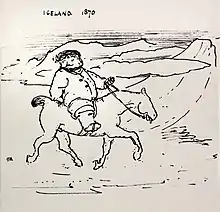
Marjorie Burns, a medievalist, writes that Bilbo's character and adventures match the fantasy writer and designer William Morris's account of his travels in Iceland in the early 1870s in numerous details. Like Bilbo's, Morris's party set off enjoyably into the wild on ponies. He meets a "boisterous" man called "Biorn the boaster" who lives in a hall beside Eyja-fell, and who tells Morris, tapping him on the belly, "Besides you know you are so fat", just as Beorn pokes Bilbo "most disrespectfully" and compares him to a plump rabbit. Burns notes that Morris was "relatively short, a little rotund, and affectionately called 'Topsy', for his curly mop of hair", all somewhat hobbit-like characteristics. Further, she writes, "Morris in Iceland often chooses to place himself in a comic light and to exaggerate his own ineptitude", just as Morris's companion, the painter Edward Burne-Jones, gently teased his friend by depicting him as very fat in his Iceland cartoons. Burns suggests that these images "make excellent models" for the Bilbo who runs puffing to the Green Dragon inn or "jogs along behind Gandalf and the dwarves" on his quest. Another definite resemblance is the emphasis on home comforts: Morris enjoyed a pipe, a bath, and "regular, well-cooked meals"; Morris looked as out of place in Iceland as Bilbo did "over the Edge of the Wild"; both are afraid of dark caves; and both grow through their adventures.[11]
Quest
The Christian writer Joseph Pearce describes The Hobbit as "a pilgrimage of grace, in which its protagonist, Bilbo Baggins, becomes grown up ... in wisdom and virtue".[12] Dorothy Matthews sees the story rather as a psychological journey, the anti-heroic Bilbo being willing to face challenges while firmly continuing to love home and discovering himself. Along the way, Matthews sees Jungian archetypes, talismans and symbols at every turn: the Jungian wise old man Gandalf; the devouring mother of the giant spider, not to mention Gollum's "long grasping fingers";[13] the Jungian circle of the self, the ring; the escape from the dark underground imprisoning chambers of the wood-elves and Bilbo's symbolic rebirth into the sunlight and the waters of the woodland river; and the dragon guarding the contested treasure, itself "an archetype of the self, of psychic wholeness".[13] Later research has extended Matthews' analysis using alternative psychological frameworks such as Erik Erikson's theory of development.[14]
Genealogy
The Tolkien scholar Jason Fisher notes that Tolkien stated that hobbits were extremely "clannish" and had strong "predilections for genealogy".[15] Accordingly, Tolkien's decision to include the Baggins and other hobbit family trees in Lord of the Rings[T 25] gives the book, in Fisher's view, a strongly "hobbitish perspective".[15] The tree also, he notes, serves to show Bilbo's and Frodo's connections and familial characteristics, Bilbo being "a Baggins and a Took".[15] Fisher observes that Bilbo is, like Aragorn, a "distillation of the best of two families"; he notes that in The Quest of Erebor, Gandalf is made to say "So naturally thinking over the hobbits that I knew, I said to myself, 'I want a dash of the [adventurous] Took ... and I want a good foundation of the stolider sort, a Baggins perhaps.' That pointed at once to Bilbo".[15]
The Tolkien critic Tom Shippey notes that Tolkien was very interested in such names, describing Shire names at length in Appendix F to The Lord of the Rings. One category was the names that had no meaning to the hobbits "in their daily language", like Bilbo and Bungo; a few of these, like Otho and Drogo in the family tree, were "by accident, the same as modern English names".[16]
Adaptations
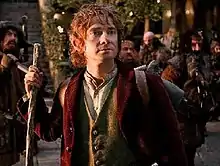
In the 1955–1956 BBC Radio serialisation of The Lord of the Rings, Bilbo was played by Felix Felton.[17] In the 1968 BBC Radio serialisation of The Hobbit, Bilbo was played by Paul Daneman.[18]
The 1969 parody Bored of the Rings[19] by "Harvard Lampoon" (i.e. its co-founders Douglas Kenney and Henry Beard) modifies the hobbit's name to "Dildo Bugger".[20]
Nicol Williamson portrayed Bilbo with a light West Country accent in the 1974 performance released on Argo Records.[21] In the 1977 Rankin/Bass animated version of The Hobbit, Bilbo was voiced by Orson Bean. Bean also voiced both the aged Bilbo and Frodo in the same company's 1980 adaptation of The Return of the King.[22]
In Ralph Bakshi's 1978 animated version of The Lord of the Rings, Bilbo was voiced by Norman Bird.[23] Billy Barty was the model for Bilbo in the live-action recordings Bakshi used for rotoscoping.[23] The 3000th story to be broadcast in the BBC's long-running children's programme Jackanory was The Hobbit, in 1979. Four narrators told the story, with Bilbo's part being played by Bernard Cribbins.[24]
In the BBC's 1981 radio serialisation of The Lord of the Rings, Bilbo is played by John Le Mesurier.[25] An unlicensed Soviet version, called Сказочное путешествие мистера Бильбо Бэггинса, Хоббита ("The Fairytale Journey of Mr. Bilbo Baggins, The Hobbit") appeared on the Leningrad TV channel in 1985.[26] In the 1993 television miniseries Hobitit by Finnish broadcaster Yle, Bilbo is portrayed by Martti Suosalo.[27]
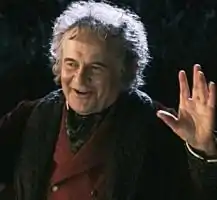
In Peter Jackson's films The Fellowship of the Ring (2001) and The Return of the King (2003) Bilbo is played by Ian Holm, who had played Frodo in the BBC radio series 20 years earlier.[28]
Throughout the 2003 video game The Hobbit, the players control Bilbo, voiced by Michael Beatie. The game follows the plot of the book, but adds the elements of platform gameplay and various side-objectives along the main quests.[29] In The Lord of the Rings Online (2007) Bilbo resides in Rivendell, mostly playing riddle games with the Elf Lindir in the Hall of Fire.[30]
In Peter Jackson's The Hobbit film series, a prequel to The Lord of the Rings, the young Bilbo is portrayed by Martin Freeman[31] while Ian Holm reprises his role as an older Bilbo in An Unexpected Journey (2012) and The Battle of the Five Armies (2014).[32]
Namesakes
In astronomy, the asteroid 2991 Bilbo was discovered and named in 1982.[33][34] The International Astronomical Union names all colles (small hills) on Saturn's moon Titan after characters in Tolkien's work,[35] and in 2012, they named one of these "Bilbo Colles".[36]
In taxonomy, the South African frog Breviceps bagginsi was described in 2003,[37] while a fossil trilobite Marjumia bagginsi from the Cambrian period was described in 1994.[38] Among the beetles named for Bilbo is the "short and robust" Pericompsus bilbo, described in 1974.[39]
See also
Notes
- Although Frodo calls Bilbo his "uncle", they were in fact first and second cousins, once removed either way (his paternal great-great-uncle's son's son and his maternal great-aunt's son).
- The French words in this phrase mean "bottom-of-[a]-bag", "Bag End", but the French word for a street with no exit, Shippey observes, is impasse.[7][8]
- The Annotated Hobbit notes also that Bilbo feels for matches (19th century) to light his pipe.[T 5][10]
References
Primary
- This list identifies each item's location in Tolkien's writings.
- The Hobbit, ch. 1 "An Unexpected Party"
- The Hobbit, ch. 2 "Roast Mutton"
- The Hobbit, ch. 3 "A Short Rest"
- The Hobbit, ch. 4 "Over Hill and Under Hill"
- The Hobbit, ch. 5 "Riddles in the Dark"
- The Hobbit, ch. 6 "Out of the Frying-Pan into the Fire"
- The Hobbit, ch. 7 "Queer Lodgings"
- The Hobbit, ch. 8 "Flies and Spiders"
- The Hobbit, ch. 9 "Barrels out of Bond"
- The Hobbit, ch. 11 "On the Doorstep"
- The Hobbit, ch. 12 "Inside Information"
- The Hobbit, ch. 15 "The Gathering of the Clouds"
- The Hobbit, ch. 17 "The Clouds Burst"
- The Hobbit, ch. 19 "The Last Stage"
- The Fellowship of the Ring, book 1, ch. 1 "A Long-expected Party"
- The Fellowship of the Ring, book 2, ch. 2 "Many Meetings"
- The Fellowship of the Ring, book 1, ch. 2 "The Shadow of the Past"
- The Return of the King, book 6, ch. 6 "Many Partings"
- The Return of the King, book 6, ch. 8 "The Scouring of the Shire"
- The Fellowship of the Ring, Prologue, "Of the Ordering of the Shire"
- The Return of the King, Appendix A, "Annals of the Kings and Rulers"
- The Fellowship of the Ring, book 1, ch. 3 "Three is Company"
- Sung by Frodo but said to have been invented by Bilbo. The Fellowship of the Ring, book 1, ch. 9 "At the Sign of the Prancing Pony"
- The Hobbit, ch. 19 "The Last Stage"
- The Return of the King, "Appendix C, Baggins of Hobbiton
Secondary
- The Merchant of Venice, Act 2, scene 7
- Shippey, Tom (2013) [2007]. "Poems by Tolkien: 'The Adventures of Tom Bombadil'". In Drout, Michael D. C. (ed.). J.R.R. Tolkien Encyclopedia: Scholarship and Critical Assessment. Routledge. pp. 515–516. ISBN 978-0-415-86511-1.
- Shippey, Tom (2001). J. R. R. Tolkien: Author of the Century. HarperCollins. p. 304. ISBN 978-0261-10401-3.
- Dennison, Behind The Mask: Vita Sackville-West (18 August 2015). "Behind The Mask: Vita Sackville-West". St Martin's Press. Archived from the original on 20 September 2015. Retrieved 20 April 2020.
- Shippey cites Haigh, W. E. (1928). Glossary of the Dialect of the Huddersfield District. Oxford University Press., noting that Tolkien had written the Prologue.
- Shippey, Tom (1982). The Road to Middle-Earth. Grafton (HarperCollins). p. 66. ISBN 0261102753.
- Shippey, Tom (2001). J. R. R. Tolkien: Author of the Century. HarperCollins. pp. 5–11. ISBN 978-0261-10401-3.
- "cul-de-sac". Collins English-French Dictionary. Retrieved 20 April 2020.
- Shippey, Tom (2014). The Road to Middle-Earth: How J. R. R. Tolkien Created a New Mythology. HMH. p. 114. ISBN 978-0-547-52441-2.
- Tolkien, J. R. R. (2003) [1937]. Anderson, Douglas A. (ed.). The Annotated Hobbit. London: HarperCollins. p. 116. ISBN 978-0-00-713727-5.
- Burns, Marjorie (2005). Perilous Realms: Celtic and Norse in Tolkien's Middle-earth. University of Toronto Press. pp. 86–92. ISBN 978-0-8020-3806-7.
- Epps, Peter G. (December 2014). "Review of Bilbo's Journey: Discovering the Hidden Meaning of The Hobbit". Christianity and Literature. 64: 122–126. doi:10.1177/0148333114556596c. JSTOR 26194807.
- Matthews, Dorothy (2003). "The Psychological Journey of Bilbo Baggins". In Lobdell, Jared (ed.). A Tolkien Compass (2nd ed.). Open Court. pp. 27–39. ISBN 9780875483030.
- Collins, Rory W. (2020). "Wombs, Wizards, and Wisdom: Bilbo's Journey from Childhood in The Hobbit". Crossing Borders: A Multidisciplinary Journal of Undergraduate Scholarship. 4. doi:10.4148/2373-0978.1073.
- Fisher, Jason (2007). "Family Trees". In Drout, Michael D. C. (ed.). J.R.R. Tolkien Encyclopedia: Scholarship and Critical Assessment. Taylor & Francis. pp. 188–189. ISBN 978-0-415-96942-0.
- Shippey, Tom (2001). J. R. R. Tolkien | Author of the Century. HarperCollins. pp. 182–183. ISBN 978-0261-10401-3.
- "Genome BETA Radio Times 1923 - 2009 Listings". BBC. Retrieved 9 May 2020.
- Robb, Brian J.; Simpson, Paul (2013). Middle-earth Envisioned: The Hobbit and The Lord of the Rings: On Screen, On Stage, and Beyond. Race Point Publishing. p. 19. ISBN 978-1-937994-27-3.
Chapter 1 Audio Adaptations
- Beard, Henry (2001) [1969]. Bored of the rings : a parody of J.R.R. Tolkien's The lord of the rings. Gollancz. ISBN 978-0-575-07362-3. OCLC 47036020.
- Barnett, David (8 February 2011). "After Tolkien, get Bored of the Rings". The Guardian.
- Nicol Williamson on IMDB
- Gilkeson, Austin (24 April 2019). "Middle-earth's Weirdest Movie: Rankin-Bass' Animated The Return of the King". Tor.com. Retrieved 9 May 2020.
- Beck, Jerry (2005). The Animated Movie Guide. Chicago Review Press. p. 154. ISBN 978-1-56976-222-6.
- Hewett, Richard (4 July 2014). "NOW A MAJOR TV SERIES: AN ODE TO TELEVISION TIE-INS". Critical Studies in Television. Retrieved 9 May 2020.
- Green, Willow (29 November 2001). "Lord of the Radio". Empire (Cinemas). Retrieved 6 May 2020.
- Marshall, Colin (14 August 2014). "The 1985 Soviet TV Adaptation of The Hobbit: Cheap and Yet Strangely Charming". Open Culture.
- Robb, Brian J.; Simpson, Paul (2013). Middle-earth Envisioned: The Hobbit and The Lord of the Rings: On Screen, On Stage, and Beyond. Race Point Publishing. p. 66. ISBN 978-1-937994-27-3.
- "The Tolkien Library review of the Lord of the Rings Radio Adaptation". Retrieved 12 April 2020.
- Lamb, Kevin (2003). "Quest Log". The Hobbit PlayStation 2 Instruction Manual. Sierra Entertainment. pp. 21–22. Retrieved 22 February 2016.
- Schiesel, Seth (4 May 2007). "Finding Fellowship (Hairy Feet Optional)". The New York Times.
- White, James (22 October 2010). "Martin Freeman Confirmed As Bilbo!". Empire. Retrieved 28 November 2010.
- Kendrick, Ben (22 April 2011). "Sir Ian Holm Returning as Older Bilbo in 'The Hobbit'". Screenrant. Retrieved 9 May 2020.
- "(2991) Bilbo = 1982 HV = 1982 KB2 = 1975 JC = 1979 SY3". IAU Minor Planet Center. Retrieved 10 March 2016.
- "JPL Small-Body Database Browser: 2675 Tolkien (1982 GB)". Jet Propulsion Laboratory. Retrieved 10 March 2016.
- "Categories for Naming Features on Planets and Satellites". Gazetteer of Planetary Nomenclature. International Astronomical Union. Retrieved 29 December 2012.
- "Bilbo Colles". Gazetteer of Planetary Nomenclature. International Astronomical Union. Retrieved 14 November 2012.
- Minter, Leslie R. (June 2003). "Two new cryptic species of Breviceps (Anura: Microhylidae) from Southern Africa". African Journal of Herpetology. 52 (1): 9–21. doi:10.1080/21564574.2003.9635473. S2CID 84275858.
- Melzak, Adam; Westrop, Stephen R. (June 1994). "Mid-Cambrian (Marjuman) trilobites from the Pika Formation, southern Canadian Rocky Mountains, Alberta". Canadian Journal of Earth Sciences. 31 (6): 969–985. Bibcode:1994CaJES..31..969M. doi:10.1139/e94-086.
- Erwin, T. L. (1974). "Studies of the subtribe Tachyina (Coleoptera: Garabidae: Bembidiini), part II: a revision of the New World-Australian genus Pericompsus LeConte". Smithsonian Contributions to Zoology. 162: 1–96.
Sources
- Tolkien, J. R. R. (1937), Douglas A. Anderson (ed.), The Annotated Hobbit, Boston: Houghton Mifflin (published 2002), ISBN 0-618-13470-0
- Tolkien, J. R. R. (1954), The Fellowship of the Ring, The Lord of the Rings, Boston: Houghton Mifflin (published 1987), ISBN 0-395-08254-4
- Tolkien, J. R. R. (1955), The Return of the King, The Lord of the Rings, Boston: Houghton Mifflin (published 1987), ISBN 0-395-08256-0
.jpg.webp)